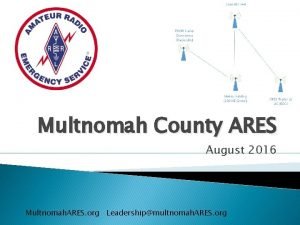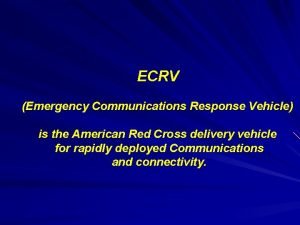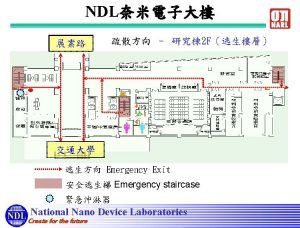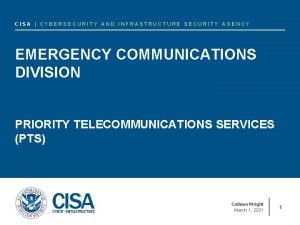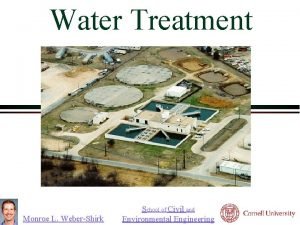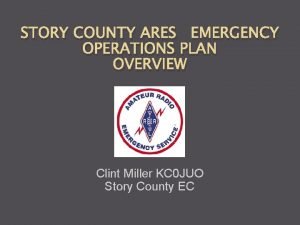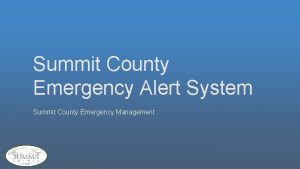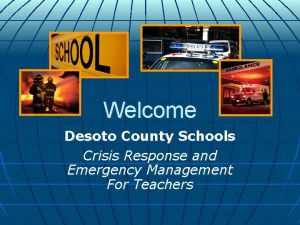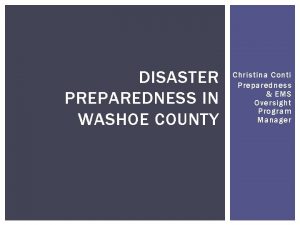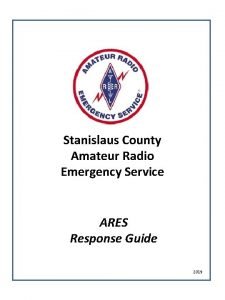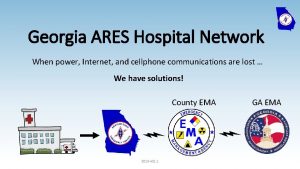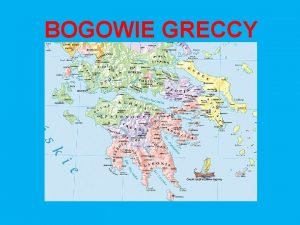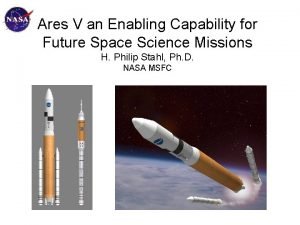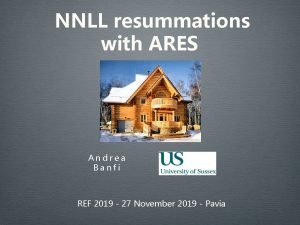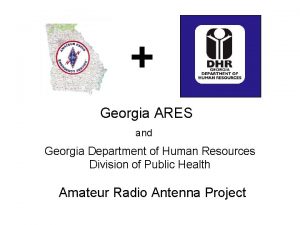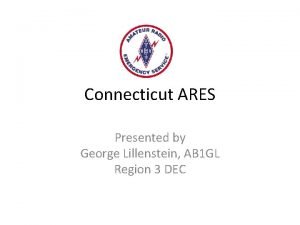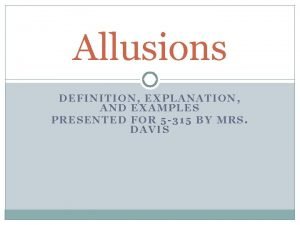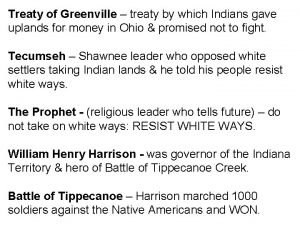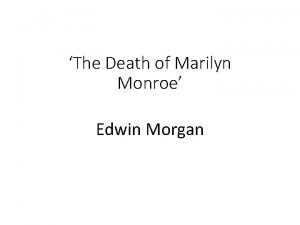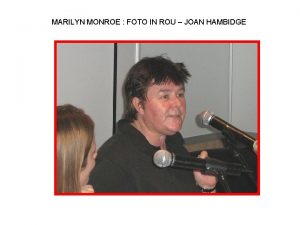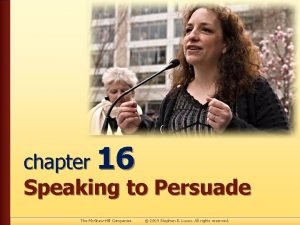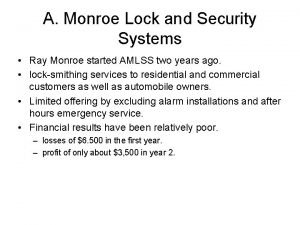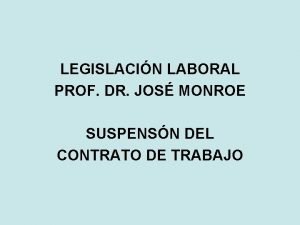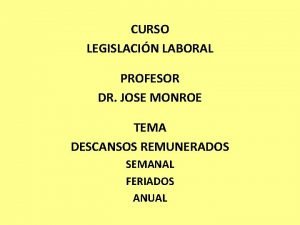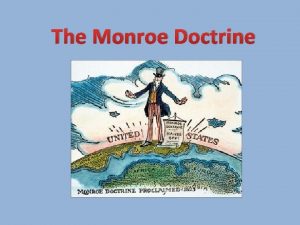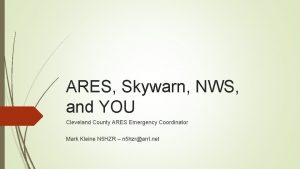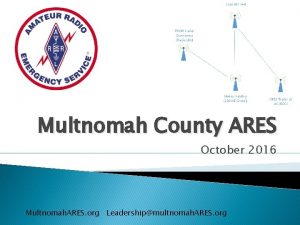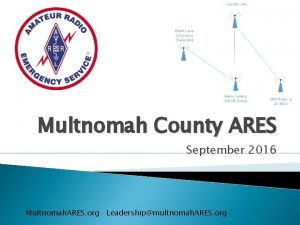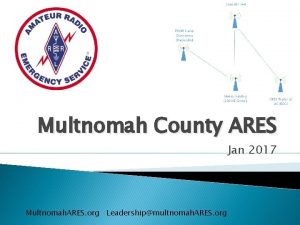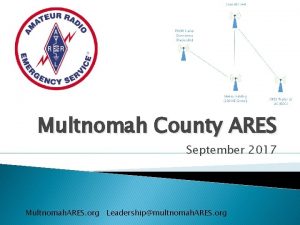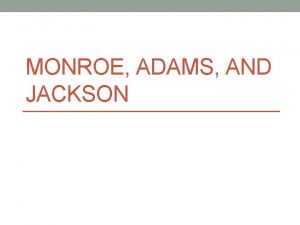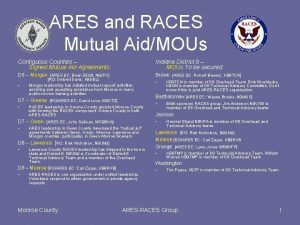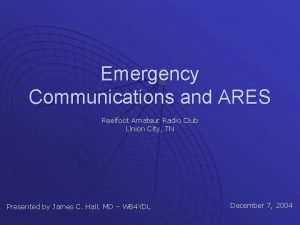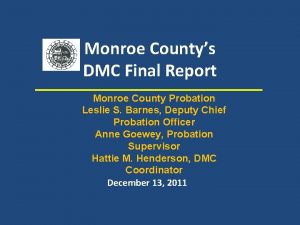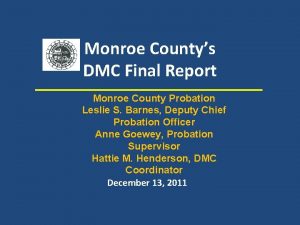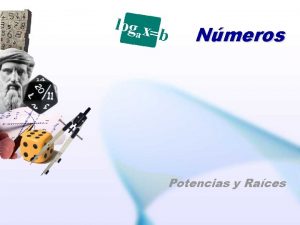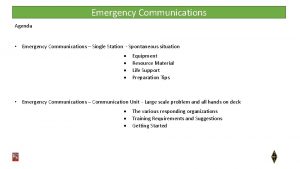Emergency Communications Monroe County ARES RACES Group Monroe


















![PREPAREDNESS Training Activities ARRL Field Day [with BARC, IUARC and BHSS ARC] June Monday PREPAREDNESS Training Activities ARRL Field Day [with BARC, IUARC and BHSS ARC] June Monday](https://slidetodoc.com/presentation_image_h/92d01ff31ba7c7c739d80ee820965b7b/image-19.jpg)


![PREPAREDNESS Formal Training 2 FEMA Online Courses [IS – Independent Study] Senior leaders, emergency PREPAREDNESS Formal Training 2 FEMA Online Courses [IS – Independent Study] Senior leaders, emergency](https://slidetodoc.com/presentation_image_h/92d01ff31ba7c7c739d80ee820965b7b/image-22.jpg)








![PREPAREDNESS Equipment Evolution 1. 2 -meter handi-talkie [HT] with OES ‘rubber duckie’ -250 Entry-level PREPAREDNESS Equipment Evolution 1. 2 -meter handi-talkie [HT] with OES ‘rubber duckie’ -250 Entry-level](https://slidetodoc.com/presentation_image_h/92d01ff31ba7c7c739d80ee820965b7b/image-31.jpg)


























![RESPONSE Amateur Radio Operations 4 146. 640 (-) [136. 5] – Primary Strategy net RESPONSE Amateur Radio Operations 4 146. 640 (-) [136. 5] – Primary Strategy net](https://slidetodoc.com/presentation_image_h/92d01ff31ba7c7c739d80ee820965b7b/image-58.jpg)










![RESPONSE Principles of Net Operation Listen to NCS [the Net Control Station] The NCO RESPONSE Principles of Net Operation Listen to NCS [the Net Control Station] The NCO](https://slidetodoc.com/presentation_image_h/92d01ff31ba7c7c739d80ee820965b7b/image-69.jpg)


























- Slides: 95

Emergency Communications Monroe County ARES – RACES Group Monroe County ARES-RACES Group 1

Why Ham Radio … What we do and How we do it … • Mitigation • Who we are, where we come from • Preparedness • Training • Equipment • Modes • Response • • NIMS and the Communications Plan Disaster Communications Repeater Operations Amateur Radio Nets and Operations • Recovery • Shelter Operations • Health and Welfare • Property Damage Surveys / Assessments • Indiana Department of Homeland Security Monroe County ARES-RACES Group 2

Emergency Communications developed by: ARES-RACES Group ARES Emergency Coordinator / RACES Officer ◦ Carl Zager, Assistant KB 9 RVB ECs and ROs ◦ Maynard Raggio, N 9 PTG, simplex operations ◦ Rob Hamros, KB 9 RNB, membership ◦ Bobby Bristoe, KB 9 UVW, net manager ◦ Kevin Pauley, KB 9 WVI, public information Monroe County ARES-RACES Group 3

Additional Members Emergency Committee • Radio Amateurs • Tom Busch, WB 8 WOR • Richard Landgrebe, • John Maassen, K 9 FK • Murl Mc. Rae, WA 9 CWT WB 9 HXP • Dan Miller, KQ 9 I • Tom Myers, KC 9 IRG • Bob Poortinga, K 9 SQL • Bill Wootton, KC 9 ACL Monroe County EMA Director • John Hooker Red Cross Director of Disaster Services • Maria Carrasquillo Monroe County ARES-RACES Group 4

Amateur … for the 'love of' …. The FCC– Title 47, Part 97 Basis and Purpose: ◦ 'Recognition and enhancement of the value of the amateur service to the public as a voluntary, non-commercial communication service, particularly with respect to providing emergency communications. ' Monroe County ARES-RACES Group 5

Bibliography Online: ◦ Monroe County ARES-RACES at http: //bloomingtonradio. org/ ◦ Monroe County EMA / RACES at http: //www. co. monroe. in. us/emergencymanagement/index. htm http: //www. co. monroe. in. us/emergencymanagement/RACES. html ◦ Volunteer Emergency Communications Plan http: //www. co. monroe. in. us/emergencymanagement/documents/05 VECM. pdf ◦ FEMA Civil Preparedness Guide http: //www. fema. gov/library/civilpg. shtm Monroe County ARES-RACES Group 6

Bibliography 2 Printed: ◦ Volunteer Emergency Communications in Monroe County, Indiana ARRL Publications: ◦ Emergency Coordinator’s Manual ◦ Public Service Communications Manual ◦ Special Events Communications Manual ◦ Operating Manual Monroe County ARES-RACES Group 7

Why Ham Radio? CB, MURS, GMRS, FRS are short-range, low-power radio services available to any citizen. Internet connectivity becoming more common but requires comparatively expensive and reliable wired or wireless resources – for all participants. Telephone requires wired connections and cell connectivity is not always reliable. But that only addresses the equipment … Monroe County ARES-RACES Group 8

Why Ham Radio 2 FCC encourages amateur radio 'to provide essential communications…when normal…not available. ' When common communications modes become overloaded or inoperable because of traffic or power, effective, accurate and timely communications can be provided by licensed hams. Monroe County ARES-RACES Group 9

Why Ham Radio 3 Amateur radio is the only communication 'system' that utilizes multi-band, multi-mode, wide-area networks independent of the 'infrastructure' or commercial power sources. A trained amateur operator can be on the air in minutes using only a battery and a wire a few feet off the ground to connect to stations a few miles away or around the world. However, it takes training, skill, coordination and discipline to effectively merge the technology with the service. Monroe County ARES-RACES Group 10

Amateur Radio Is private, non-government, non-profit. Does not fight fires, find or rescue lost people, direct traffic, or perform other law enforcement services. Does not open or staff shelters or missions, provide food, water or clothing, offer medical or counselling services. Does not predict the weather. Hams may volunteer to provide those services with or through an agency that does and may use amateur radio to support that effort. Monroe County ARES-RACES Group 11

Mitigation • Identify resources • Organize, associate Monroe County ARES-RACES Group 12

MITIGATION Monroe County ARES-RACES Group Independent, unaffiliated hams, Operators from Bloomington, Indiana University, Hoosier Hills, Owen County, BHS South amateur radio clubs, Members of Monroe County Repeater Association, W 9 WIN, EARS, Volunteers with Monroe County Red Cross, Salvation Army, Argus K 9 SAR, IKCC S-R, Citizens Corps, CAP, MARS, Trained NWS-Skywarn weather spotters. Monroe County ARES-RACES Group 13

MITIGATION Amateur ARES Radio Emergency Service is an organized pool of hams who volunteer themselves and their equipment to local non-profit agencies, as well as to local, county and state government, to provide primary or backup communications links. Any licensed amateur is eligible to volunteer him/herself and her/his equipment to community service with ARES. The ARES Emergency Coordinator is a ham appointed by the ARRL District EC. In Monroe County, that is Carl Zager, KB 9 RVB. In Owen County, that is John Sullivan, WD 9 BKA Monroe County ARES-RACES Group 14

MITIGATION Radio RACES Amateur Civil Emergency Service is a special phase of amateur radio, sponsored by FEMA (Federal Emergency Management Agency), an arm of the Department of Homeland Security (DHS), that provides radio communications for civil-preparedness purposes only. These emergencies are no longer limited to war-related activities, but can include natural disasters such as fires, floods and earthquakes. RACES hams must be enrolled in a local EMA/DHS civil preparedness group. The RACES Officer is a ham (Carl Zager, KB 9 RVB) appointed by the local EMA/DHS (John Hooker), Monroe County ARES-RACES Group 15

MITIGATION Monroe County ARES and RACES Partnerships ARES-RACES Group 16

MITIGATION ARES and RACES Mutual Aid/MOUs Contiguous – Signed Mutual Aid Agreements: Indiana District 8 – MOUs To be secured: Brown [EC: Robert Bowers, KB 9 TCN] D 5 -- Morgan [ARES EC: Brian Elliott, N 9 JPX] [RO: Delbert Davis, K 9 DEL] • • Morgan leadership has initiated mutual support activities, assisting and accepting assistance from Monroe in many public service training activities. D 7 -- Greene [RO/ARES EC: David Love, W 9 XTZ] • Bartholomew [EC: Wayne Brooks, N 9 MUS] RACES leadership in Greene County assisted Monroe County with forming the RACES component. Greene County is now ARES-RACES. ARES leadership in Owen County developed the 'mutual aid' agreements between Owen, Green, Monroe, Lawrence and Morgan counties, participates in Owen-Monroe Skywarn. D 8 – Jackson [no signed MOU] • Monroe [RO/EC: Carl Zager, KB 9 RVB Orange [EC: Larry Jones WB 9 HFP] • Lawrence County RACES leadership has stepped to the fore in state and District 8. N 9 UMJ is Coordinator of District 8 Technical Advisory Team and a member of the Overhead Team. Hershel Zhand N 9 KPA is member of D 8 Overhead and Technical Advisory teams Lawrence [RO: Rick Nicholson, N 9 UMJ] D 8 -- Lawrence [RO: Rick Nicholson, N 9 UMJ] • EMA sponsors RACES group. Jim Anderson N 9 VXW is member of D 8 Overhead and Technical Advisory teams Jackson D 7 -- Owen [ARES EC: John Sullivan, WD 9 BKA] • KB 9 TCN is member of D 8 Overhead Team. Rick Woehlecke K 9 VM is member of D 8 Technical Advisory Committee. Don’t know if this is joint ARES-RACES organization. KB 9 TMP is member of D 8 Technical Advisory Team. William Warren KB 9 TMP is member of D 8 Overhead Team Washington • Tim Peace, N 9 TP is member of D 8 Technical Advisory Team D 8 -- Monroe [RO/EC: Carl Zager, KB 9 RVB] Monroe County ARES-RACES Group 17

Preparedness • • Training Equipment Operating Modes Warnings Monroe County ARES-RACES Group 18
![PREPAREDNESS Training Activities ARRL Field Day with BARC IUARC and BHSS ARC June Monday PREPAREDNESS Training Activities ARRL Field Day [with BARC, IUARC and BHSS ARC] June Monday](https://slidetodoc.com/presentation_image_h/92d01ff31ba7c7c739d80ee820965b7b/image-19.jpg)
PREPAREDNESS Training Activities ARRL Field Day [with BARC, IUARC and BHSS ARC] June Monday Night ARES nets [weekly] ◦ 7: 30 (1930 UTC -5) 146. 640 repeater ◦ 8: 00 (2000 UTC -5) 146. 580 simplex State March Tornado Test Statewide [with EMA/sirens] RACES Tests January + July SET with National Traffic System Local Tabletops and Exercises Monroe County ARES-RACES Group September [arranged] 19

PREPAREDNESS Training Activities 2 Community Events ◦ Indiana State Science Olympiad K 9 IU March and in 2006, National Science Olympiad June ◦ Red Eye Relay Race WB 9 VPG July ◦ Hoosier Hills Bicycle Ride KB 9 RVB September ◦ Hilly Hundred Bicycle Tour KC 9 IRG October Monroe County ARES-RACES Group 20

PREPAREDNESS Formal Training ARRL Activities: ◦ EC-001 – Emergency Communications ◦ EC-002 – EC Level II ◦ EC-003 – EC Level III Amateurs wishing to volunteer for specialized Search and Rescue should seek training with the specific activity: ◦ National Cave Rescue Commission Indiana Karst Cave Conservancy http: //www. caves. org/io/ncrc-cr/ocr. htm ◦ Argus K 9 SARS Monroe County http: //www. argusk 9. org/ ARES-RACES Group 21
![PREPAREDNESS Formal Training 2 FEMA Online Courses IS Independent Study Senior leaders emergency PREPAREDNESS Formal Training 2 FEMA Online Courses [IS – Independent Study] Senior leaders, emergency](https://slidetodoc.com/presentation_image_h/92d01ff31ba7c7c739d80ee820965b7b/image-22.jpg)
PREPAREDNESS Formal Training 2 FEMA Online Courses [IS – Independent Study] Senior leaders, emergency management practitioners, disaster workers, and first responders, including ARES volunteers and RACES enrollees are required to demonstrate a working knowledge of ICS, NIMS and NRF because of the emphasis on inter-agency cooperation. ARRL-ARES leadership and local EMA RACES leadership are requiring • • IS-00100 Introduction to ICS [Incident Command System] IS-00200 ICS for Single Resources and Initial Action IS-00700 NIMS - National Incident Management System: An Introduction IS-00800 b NRF – Introduction [National Response Framework all of which are available from the FEMA Training web address http: //training. fema. gov/EMIWeb/IS/crslist. asp Those who completed either IS-800 or IS-800 a do not need to complete IS-800 b. Monroe County ARES-RACES Group 22

PREPAREDNESS Formal Training 2 Other appropriate FEMA IS offerings [Certificates held by Monroe County ARES-RACES Officers] IS-1 Emergency Manager IS-7 Hazardous Materials IS-15 Special Events Planning IS-120 Community Disaster Exs IS-139 Exercise Design IS-195 Basic IC System Monroe County IS-271 IS-275 IS-288 IS-292 IS-362 IS-701 ARES-RACES Group Hazardous Weather & Risk Role of EOC in Community Role of Volunteer Agencies Disaster Basics Multi-haz Em for Schools Multi Agency Coordination 23

PREPAREDNESS Formal Training 3 Red Cross: Disaster Services Sheltering Feeding Transportation Disaster Assessment Volunteer Staffing Health Services Client Casework Facilities Supply • Community Disaster Education Monroe County ARES-RACES Group 24

PREPAREDNESS Formal Training 4 Skywarn – National Weather Service: Weather Safety ◦ Watch v. Warning ◦ Flash Floods ◦ Lightning Spotter Training ◦ Thunderstorms and Tornadoes ◦ Winter Storms Monroe County ARES-RACES Group 25

PREPAREDNESS The Ready Kit The ARRL Operating Manual contains the seminal Go Kit, Ready Kit information. Monroe County Volunteer Emergency Communications Plan has short-term and extended service packages. RACES -- www. races. org/gokit. htm (5 pgs) ARES-RACES Newsletter has local survey information and suggestions … Monroe County ARES-RACES Group 26

PREPAREDNESS Our Version Basic Deployment Go Kit: ◦ What you need to be self-sufficient during a 12 hour or 72 -hour emergency communications response. ◦ A 12 -hour Go Kit: Most local responses will not exceed 12 hours without a personnel change. Try to use a single bag, such as a back pack or a large gym bag for easy, hands-free carrying. The fewer items to carry, the better. Monroe County ARES-RACES Group 27

PREPAREDNESS Radio Gear 2 meter radio / HT (if multiband, 2 m/440) • Power Extra AA replacement pack if available for your HT Quick recharger(s) for battery type(s) Wall plug adapter Vehicle accessory (i. e. , cigarette lighter) adapter Appropriate power supply, extension cord, grounding plugs, extra fuses if using mobile as ‘base’ station o Adequate ventilation if using automotive batteries o o o • • • Speaker Mic/Ear bud for noisy locations Appropriate portable/mobile antenna connections and adapters Ground plane (pizza pan/cookie sheet) to increase gain w/ mag mount SWR meter and Extra Coax Operator manual or instruction card for the radio(s)’ programmable functions – frequency memory, offset, PL settings, using reverse and simplex Monroe County ARES-RACES Group 28

PREPAREDNESS Other Gear Identification o ARES or ARES/RACES Photo I. D. , Agency IDs o Copy of your FCC License o Drivers License Other Equipment o Pens and/or pencils & paper o Map(s) of the area o Flashlight(s) and extra batteries o Credit card or some cash for fuel, snacks and phones o List of important phone numbers Monroe County Food – Water - Clothing o Appropriate dress for the weather and outside the vehicle, base or shelter: i. e. , Sun screen, insect repellent (DEET), rain gear (pocket poncho), cold weather gear, hand warmer o Complete change of clothing, escpecially cocks. Keep it dry in plastic. Sleeping bag, pillow o Bottle(s) of water and some munchies. o Hand cleanser/disinfectant, dry towel. o Personal prescription drugs with instructions and 1 st aid kit. ARES-RACES Group 29

PREPAREDNESS Emergency Gear Blanket. You may have an occasion to use it to treat an injury victim for shock, or folded to make a splint. You can even move an injured person using it to make a litter (however, don’t ever move an injured person unless they are in danger of further injury by staying where they are!) In winter weather, a blanket can have more immediate personal importance. Hypothermia is a dangerous situation. Monroe County ARES-RACES Group 30
![PREPAREDNESS Equipment Evolution 1 2 meter handitalkie HT with OES rubber duckie 250 Entrylevel PREPAREDNESS Equipment Evolution 1. 2 -meter handi-talkie [HT] with OES ‘rubber duckie’ -250 Entry-level](https://slidetodoc.com/presentation_image_h/92d01ff31ba7c7c739d80ee820965b7b/image-31.jpg)
PREPAREDNESS Equipment Evolution 1. 2 -meter handi-talkie [HT] with OES ‘rubber duckie’ -250 Entry-level radio for new operators. 1 -5 watts power. o o Replace rubber duckie with a ‘gain’ antenna $150 $50 Increase Tx output by 3 -4 DBls Switch to a ‘mag mount’ $35 -100 Additional range operating mobile or using ‘pie tin’ ground on base. 2. Upgrade to 2 m/440 dual band HT $250600 Possibly w/ TNC for APRS, Upgrade antennas to add UHF capabilities 3. Upgrade to 2 -meter mobile $200300 Higher power (10 -25 -50 watts), upgrade antenna $75 -100 4. Upgrade to 2 m/440 dual band mobile $300750 Monroe County HF capabilities to mobile ARES-RACES Group 5. Add operation $4501000 31

PREPAREDNESS Preparedness Checklist Check that family and property are safe and secure. Be prepared to operate. Check all equipment and connections. Be prepared to deploy to an assignment/location with Ready-Kit. Leave the house dressed for the weather expected in the next few hours (especially if you deploy to ‘spot’ severe weather in fair conditions before it’s onset. Most of our severe weather events are cold front driven and are followed by considerably cooler weather. Monitor assigned frequency and follow check-in instructions. Enter assigned frequency(s) on log sheet. If you plan to use a mobile radio as a base station; be sure to include appropriate power supply, some extension cord with a third grounding plug, extra automotive fuses for your power cords. If carrying an automotive battery, be sure it is clean and will not spill battery acids, and use it in well ventilated areas! Label your equipment (you may loan equipment or leave a station you’ve set up for use and work somewhere else, or you may even leave stuff in vehicles accidentally) Monroe County ARES-RACES Group 32

PREPAREDNESS Alternative Modes for Em. Comm • Why 'Alternative Modes'? o Efficiency (use 'Right Tool' for the job) o Provide both short haul and long haul data communications in event of Internet failure o Provide 'situational awareness' o Provide reliability and redundancy Monroe County ARES-RACES Group 33

PREPAREDNESS Which Alternative Modes? Automatic Packet Report System (APRS) Winlink 2000 Digital SSTV (Win. DRM, Easy. Pal) Others ◦ PSK 31, PSKmail ◦ Pactor ◦ Win. DRM voice, FDMDV ◦ Olivia, Hellscheiber, MFSK Monroe County ARES-RACES Group 34

PREPAREDNESS APRS Developed by Bob Bruninga, WB 4 APR, as a method of broadcasting (connection-less) data using Packet Radio. Uses both RF and Internet to carry data. Most common use is vehicle tracking. Also provides messaging and 'object data' Monroe County ARES-RACES Group 35

PREPAREDNESS APRS 2 Most APRS clients provide mapping capabilities which, when used with APRS 'objects', can provide real-time 'situational awareness' (Location and status of assets, weather, disaster areas, etc. ) APRS specification also defines a common bulletin which could be useful for Em. Comm, although most clients do not provide support for it. Monroe County ARES-RACES Group 36

PREPAREDNESS APRS use at Hilly 100 NCS Monroe County ARES-RACES Group 37

PREPAREDNESS Accessing APRS Radios: Kenwood TM-D 700, TM-D 710, and TH-D 7 A provide built-in APRS functions. APRS Client software (used with TNC, or soundcard interface and AGWPE / sound modem): o UI-View 32 o Win. APRS o AGWTracker o Xastir (Linux) o Others (APRS-SA, APRSdos, APRSkml, etc) APRS Trackers: ◦ Opentracker ◦ Tiny. Trak Monroe County ARES-RACES Group 38

PREPAREDNESS Winlink 2000 What? ◦ Protocol, software and modes which implement a global email system over RF and the Internet. ◦ Uses Pactor over HF, AX. 25 packet over VHF/UHF Why? ◦ Ad Hoc Committee on ARES Communications (ARESCOM) July 2004 Final Progress Report & Recommendations ◦ 'It is recommended that the Board endorse the use of Winlink 2000 in the ARRL Field Organization…' Monroe County ARES-RACES Group 39

PREPAREDNESS Winlink 20002 How? ◦ Must be a registered user! ◦ Use client software: Airmail (HF) and Paclink (VHF/UHF) Potential: Will facilitate messaging during either RESPONSE or RECOVERY activities. Monroe County ARES-RACES Group 40

PREPAREDNESS Digital SSTV Provides a method of transmitting any digital file (not just images) using error detecting and correcting protocols. Used in a simplex (station-to-station) or multistation (net) operation over HF/VHF/UHF to exchange. Provides reasonable data bandwidth over a 2. 5 KHz channel using either SSB or FM (about 2400 bps throughput). Monroe County ARES-RACES Group 41

PREPAREDNESS Digital SSTV 2 Software clients (Windows only): o Easy. Pal o Win. DRM o Others in development (DM 780) Potential: o Transmission of information from sites to EOCs Monroe County ARES-RACES Group 42

PREPAREDNESS Digital Voice Modes Both hardware and software based modes: ◦ Hardware: AOR Voice Modem, Icom DSTAR ◦ Software: Win. DRM, FDMDV Why? ◦ Provide hi-quality noise-free audio. ◦ Provides some confidentiality to communications and immunity to intercept. ◦ FDMDV requires only 1100 Hz bandwidth. Monroe County ARES-RACES Group 43

PREPAREDNESS Alternate Modes: What needs to done? Develop local expertise and experience in using these modes. Have software downloaded and installed on laptops and home PCs. Provide local infrastructure for APRS and Winlink 2000. Monroe County ARES-RACES Group 44

Response • Initial response • Tactical Traffic • Health & Welfare Traffic Monroe County ARES-RACES Group 45

RESPONSE Initial Response Checklist Deploy to assignment/location. Get tactical call sign or confirm tactical call with NCO. Log all traffic sent or received, and initiate personal event log of dates and times of other various and significant events performed while activated. Use a formal ARRL Message Form when a precise record is required. Obtain tactical call sign for location/assignment (if appropriate). Use tactical call sign, while observing FCC’s tenminute ID rule. Monitor your assigned frequency at all times. Request permission from NCS before changing frequency. Notify (and/or request permission from) NCS if you have to leave frequency or location. Monroe County ARES-RACES Group 46

RESPONSE Emergencies! Blackouts Chemical Emergencies Drought Earthquakes Fires Floods Heat Waves Mudslides Terrorism Thunderstorms Tornadoes Wildfires Winter Storms The area is likely to be a destination for evacuees from other locations, so local communications volunteers may be activated for hurricanes and volcanic eruptions, as well as other distant emergency events. Monroe County ARES-RACES Group 47

RESPONSE Emergency Responses Central Indiana Skywarn Severe weather ◦ Tornado ◦ Funnel cloud ◦ Thunderstorm ◦ Flash Flood ◦ Lightning ◦ Blizzards Monroe County ARES-RACES Group 48

RESPONSE Other Responses Hazardous Materials Search and Rescue ◦ Fox hunts are a sub-set of S+R activity ◦ Assist Law Enforcement track signals Shelter Operations Heath and Welfare Disaster Assessment Monroe County ARES-RACES Group 49

RESPONSE NIMS The National Incident Command System promotes interagency collaboration on domestic incidents. Incident Command System (ICS) is a component of NIMS. 1. 2. 3. 4. Monroe County Clear text Unified command Flexibility Concise ‘span of control’ ARES-RACES Group 50

RESPONSE 1. Clear Text NIMS and ICS principles require that all transmissions be in clear text. No ’ 10’ codes. This assures that all cooperating agencies understand each other’s communications. Monroe County ARES-RACES Group 51

RESPONSE 2. Unified Command NIMS requires that all agencies come under the authority of a single Incident Commander. The ICS command is determined by the nature of the event and the size of the response and may be changed during the event. Monroe County ARES-RACES Group 52

RESPONSE 3. Flexibility Emergency events are seldom stable. NIMS/ICS recognizes the need to be able to adjust components of the response to the nature of the event. Monroe County ARES-RACES Group 53

RESPONSE 4. Concise ‘span of control’ Emergency response operations will always include ◦ Planning ◦ Logistics [amateur radio support] ◦ Operations ◦ Finance components Small numbers in operational groups mean more effective coordination. Monroe County ARES-RACES Group 54

RESPONSE Amateur Radio Operations Events usually begin as ARES and migrate, if necessary, to EMA/DHS-RACES. Command of any event falls to the appropriate authority: ◦ Public Service: the sponsoring agency ◦ Skywarn: National Weather Service ◦ Emergency: Civil preparedness: EMA Other events: Red Cross Ham Monroe County volunteers are communicators. ARES-RACES Group 55

RESPONSE Amateur Radio Operations 2 During an ARES response, any ham may participate and pass traffic. ◦ The purpose of enrolling in ARES is to register equipment and volunteer for service. ◦ It is NOT exclusionary. Even if an event comes under the command of EMA/DHS, ARES may be used by all agencies. But, if a RACES emergency is declared by EMA/DHS, only RACES operators may use the frequencies. While RACES has the authority to commandeer a wide range of frequencies, only those necessary will be used for an event. Monroe County ARES-RACES Group 56

RESPONSE Amateur Radio Operations 3 As much as possible, the operational nets shall be on 2 meters (VHF), which has an historic role in emergency communications. More operators, currently, have VHF capability. The WB 9 TLH repeater has excellent coverage in and around Monroe County. Growing numbers are adding 70 cm (UHF) capabilities, and this area has an two excellent 440 systems, covering nearly all of southern Indiana. Monroe County ARES-RACES Group 57
![RESPONSE Amateur Radio Operations 4 146 640 136 5 Primary Strategy net RESPONSE Amateur Radio Operations 4 146. 640 (-) [136. 5] – Primary Strategy net](https://slidetodoc.com/presentation_image_h/92d01ff31ba7c7c739d80ee820965b7b/image-58.jpg)
RESPONSE Amateur Radio Operations 4 146. 640 (-) [136. 5] – Primary Strategy net frequency ‘Strategy’ is the ‘Big Picture’ of the event; overall command review, general tactics and tactical/resource traffic. 146. 940 (-) [136. 5] – 1 st Strategy Backup, Tactical sub-net 147. 180 (+) [136. 5] -- 2 nd backup, Tactical sub-net 443. 775 (+5) [136. 5] – Primary Tactical sub-net frequency capable of linking Monroe, Brown, Lawrence, Greene, Putnam, Washington, and Marion counties, and with EARS link, can be stretched to Evansville and Illinois or possibly, state-wide. 146. 580 /simplex/ Primary simplex Tactical frequency short-range tactical nets but, for some operators and equipment, capable of county-wide coverage Monroe County ARES-RACES Group 58

RESPONSE Amateur Radio Operations 5 The net control station and/or officials on the designated emergency net will provide additional instructions, including information on frequencies used or other resource and tactical nets. Tactical/Resource nets [sub-nets] may be created to serve communications groups and subjects on any of the associated repeaters or simplex. Liaison and liaison nets may be established with operators and repeaters in other locations on other frequencies. Monroe County ARES-RACES Group 59

RESPONSE 1. 2. 3. 4. 5. 10 Em. Comm Rules Monitor and remain on assigned frequency. Use mode/band selected by leadership or cooperating agency. Remain silent until you have traffic or are called by the NCS/NCO. Report first-hand knowledge. Messages being relayed must be authenticated. Avoid initiating disaster or emergency reports or traffic. ARS communicates; agencies supply the content. Monroe County ARES-RACES Group 60

RESPONSE 6. 7. 8. 9. 10. 10 Em. Comm Rules 2 Strive for efficiency. Share shifts, responsibilities with other operators. Be courteous and cooperate with other communications services. Use all communications channels intelligently. Know and follow FCC regulations. Clear text caveat: do not transmit names without prior administrative approval. Don’t broadcast. Hams support agencies during event; do not provide information to public. Monroe County ARES-RACES Group 61

RESPONSE Amateur Radio Nets Any ham may institute a net, but no amateur operator has independent authority to declare an emergency. Open Net – declared, but usually normal use of the repeater continues while operators rag chew, or share information or concerns prior to an event. May have an NCO. Directed Net – public service and practice nets. Normal use of the frequency is allowed. Will have an NCO. Monroe County ARES-RACES Group 62

RESPONSE Amateur Radio Nets 2 Formal Directed Net: specific nets for specific purposes. ◦ May be activated at the request of: National Weather Service [Skywarn - ARES] Red Cross (or other agency) [ARES] Mo. Co EMA will often use ARES for civil response emergencies. ◦ Usually, normal use of the frequency is curtailed or limited by NCO. Only a RACES operator may activate a RACES net at the request of EMA. Access may be limited to RACES operators. Cave Rescue may only be activated by the Indiana Karst Conservancy or the Indiana State Police. Monroe County ARES-RACES Group 63

RESPONSE A Weather Example A fictional scenario to demonstrate net operations … Severe weather is possible. ◦ Hams begin to plan a response by finding out who will be available for strategic assignments: Net Control Operator, Alternate or Back-up NCOs Liaison station with Indianapolis NWS on 146. 97 or 442. 65 system Liaison station with inter-county 443. 775 system Liaison station(s) with adjacent county nets and operators [147. 24, 146. 73, 146. 03, 146. 79] Monroe County ARES-RACES Group 64

RESPONSE A Weather Example 2 A fictional scenario to demonstrate net operations Severe weather is eminent. ◦ Reports from counties along the typical storm path indicate NWS Warnings and Watches. ◦ Operators may continue to plan and organize or may decide to declare an Open Net*, allowing normal use of the repeater while operators share information or concerns and formalize event assignments. *- This protocol eliminates past confusion between the terms 'informal net' and 'in formal net’ to describe net status. ‘Informal’ will not be used to describe ‘open’ or practice net activity. Monroe County ARES-RACES Group 65

RESPONSE A Weather Example 3 A fictional scenario to demonstrate net operations A severe weather Warning is posted for adjacent counties, with a Watch block for Monroe. ◦ NWS may request Monroe 'bring up' a Formal* Directed Net for the specific purpose of observing hail, high winds, tornadoes, funnel clouds, and tornado-spawning conditions – or specific conditions needed to clarify NWS radar images. ◦ At this time, NCO will request that normal use of the frequency be curtailed. *- This protocol eliminates past confusion between the terms 'informal net' and 'in formal net’ to describe net status. ‘Informal’ will not be used to describe ‘open’ or practice net activity. Monroe County ARES-RACES Group 66

RESPONSE A Weather Example 4 A fictional scenario to demonstrate net operations Spotter stations: ◦ While NCOs and liaison assignments often fall to experienced operators with better connectivity, the KEY to an effective Skywarn operation are the 'eyes on the ground. ‘ ◦ NWS needs trained weather spotters watching the sky to confirm NWS radar images. ◦ The reports from these operators are what will be relayed to Indianapolis. Monroe County ARES-RACES Group 67

RESPONSE A Weather Example 4 A fictional scenario to demonstrate net operations Liaison stations: ◦ An effective liaison between communication stations should understand the operation of both organizations. Monitoring the ‘partner’ station for relay requests Monitoring the Primary station for direction Contacting and relaying between stations ◦ An information liaison tasked with gathering one-way information (such as radar data or location of agency personnel) needs to clearly identify the source of information for the net. Monroe County ARES-RACES Group 68
![RESPONSE Principles of Net Operation Listen to NCS the Net Control Station The NCO RESPONSE Principles of Net Operation Listen to NCS [the Net Control Station] The NCO](https://slidetodoc.com/presentation_image_h/92d01ff31ba7c7c739d80ee820965b7b/image-69.jpg)
RESPONSE Principles of Net Operation Listen to NCS [the Net Control Station] The NCO [Net Control Operator] will be 1. Building an asset list of operators, equipment, and locations, 2. Announcing criteria for check-in, 3. Establishing content of traffic. Monroe County ARES-RACES Group 69

RESPONSE Principles of Net Operation 2 1. Building an asset list of operators, equipment, and locations : ◦ Who is available? ◦ Where are they located? ◦ Are they mobile or base? ◦ What can their equipment do? ◦ How long are they available? Monroe County ARES-RACES Group 70

RESPONSE Monroe County Asset List ARES-RACES Group 71

RESPONSE Principles of Net Operation 2 2. Announcing criteria for check-in : ◦ Any amateur operator / Specific operators: Reporting specific information � 'check in if reporting 1” hail. . ' In a particular location � '. . . need spotters in SE quadrant of county. . ' With specific equipment � '. . . need operator able to reach 146. 97. . ' With special knowledge or skills � '. . . any operator with variable DF equipment. ' Listen Monroe County ARES-RACES Group 72

RESPONSE Principles of Net Operation 3 3. Establishing content of traffic : ◦ Any traffic / Specific traffic: Requested reports of observed events � i. e. , hail, high winds, downed trees, etc. From a particular location � i. e. , '. . . operator at Williams Dam. . ' To/from a specific cooperating agency � i. e. , 'NWS liaison. . . Red Cross liaison' Listen Monroe County ARES-RACES Group 73

RESPONSE Principles of Net Operation 4 The Directed Net: ◦ All traffic flows through the NCS. ◦ NCO sets the tone with instructions and information. ◦ NCO may allow Third-party traffic – to permit non-hams to pass traffic directly ‘Direct traffic’ – to permit hams to communicate without going through NCS. These practices reduce the possibility of error in traffic ◦ Check-out: If you check in to a net, please check out. NCOs will periodically make health and welfare checks of amateur operators. ◦ NCO may close net with a roll-call of active check-ins. Monroe County ARES-RACES Group 74

RESPONSE Amateur Radio Traffic Tactical traffic ◦ The first response communication in an emergency situation. ◦ Instructions or inquiries: ‘Send ambulance. ’ ‘Where are water supplies? ’ ◦ Tactical traffic is generally unformatted and seldom written, but all traffic should be logged to protect both the radio amateur and the cooperating agency. Formal traffic ◦ Generally long-term communications, often cast in ARRL message format and handled on NTS nets. ◦ Health and welfare traffic is usually formal. Monroe County ARES-RACES Group 75

RESPONSE Amateur Radio Traffic 2 Routine ◦ The expected traffic and operational communications. On a Formal Directed Net, the flow is controlled by the NCO who may allow ‘third-party’ traffic and ‘direct traffic’ to facilitate information exchange. Break ◦ The normal, polite request for an opportunity to interrupt an ongoing contact is the lowest priority of interruption. Break is also often recognized during any Directed Net. The NCS can break back with a higher priority should events warrant a change in net status. Monroe County ARES-RACES Group 76

RESPONSE Amateur Radio Traffic 3 NCS/NCO, or an operator on any contact, will always stop everything and answer the following interruption priority calls immediately: 2. Priority [or Time Value] 1. Emergency The second highest level of interruption, Priority, means the traffic concerns an immediate safety issue regarding human life or injury, or impending property damage. The highest level of priority, Emergency, is reserved for only danger-of-death or seriousinjury-if-message-is-not-heard-immediately messages. Monroe County ARES-RACES Group 77

RESPONSE Using Repeater Operation a repeater during an emergency: ◦ Power – Reduce power to avoid over-powering and conserve batteries. If tones are off, lower power avoids keying near-by, same frequency repeaters. ◦ Pause – Allow 2 -3 second break after each transmission to permit potential Emergency or Priority traffic. . . ◦ Pause – On linked systems, hold key 2 -3 seconds before transmitting to allow all repeaters to come online. ◦ Articulate. Speak across, not into, the mic. Talk low, slow, calm. ◦ Think. Stick to the facts. Control emotions. Write out what you need to transmit. ◦ Listen much. Transmit little. Monroe County ARES-RACES Group 78

RESPONSE Liaison Activities The Operational frequencies include both local and wide-area nets, both Strategy [Big Picture] and Tactical/Resource nets. Strategy [146. 64 (-)] Tactical [443. 775 (+5)] 2 m Tactical [146. 94 (-), 147. 18 (+), 146. 58 /s/ ] • Locations identified by EMA, Red Cross or other agency: • • NWS [146. 97 (-), 442. 65 (+5) ] • Area NOAA frequencies • • Indiana Traffic Net [3. 910] • • • Monroe County Staging areas EMA / EOC Red Cross Chapter House Shelter locations Hospitals Law enforcement Fire response Service centers ARES-RACES Group 79

Recovery Health & Welfare Traffic Damage Assessment Monroe County ARES-RACES Group 80

RESPONSE RECOVERY Shelter Operations Shelter operations may occur during the RESPONSE phase and during the RECOVERY stages of an event. Support may be provided by both ARES and RACES operations. Shelter during RESPONSE could be service at the site – i. e. , a stranded motorist. Shelter during RECOVERY could mean serving families displaced by weather. Monroe County ARES-RACES Group 81

RESPONSE RECOVERY Shelter Operations 2 Initial communications will probably involve inter/intra-agency logistics to open the facility. • ARS will support shelter activities ◦ ◦ ◦ Equipment logistics Victim location and identification Emergency food and water information Medical equipment Material distribution Life-and-death communication [Emergency / Priority] Monroe County ARES-RACES Group 82

RESPONSE RECOVERY Shelter Operations 3 Shelter clients need to be able to inform, advise, and reassure friends and relatives of their status. Hams will pass Health and Welfare traffic from the shelter to cooperating agencies and to HF traffic nets through a liaison. Incoming Health and Welfare will be handled after all outgoing traffic is passed. Monroe County ARES-RACES Group 83

RECOVERY Property and Damage Assessment Both ARES and RACES may support Property and Damage Assessment teams. EMA may request surveys to ascertain the amount of outside assistance needed in an area. Red Cross uses DA to calculate initial impact estimates to aid recovery. Hams can train to survey or may ridealong to provide instantaneous contact with Chapter or headquarters. Monroe County ARES-RACES Group 84

Indiana Department of Homeland Security What’s Next? 10 Homeland Security Districts ◦ District 8 Bartholomew, Brown, Jackson, Lawrence, Monroe, Orange and Washington counties District Planning Council Program ◦ DP Oversight Committee (DPOC) President of County Commissioners of each County Mayor/Town Board President most populous city/town in each district County ◦ DPC Local emergency responders Emergency managers Other key agencies District Overhead Team representative Monroe County ARES-RACES Group 85

Indiana Department of Homeland Security What’s Next? 2 Oversight Planning Committee ◦ Appoint members of the DPC ◦ Provide executive oversight, support, guidance DPC ◦ Conduct a District Homeland Security and Preparedness Assessment ◦ Develop and implement a District HS Strategy ◦ Develop a Crisis Communications and Public Information Plan ◦ Develop and implement a District Training and Exercise Program ◦ Sponsor and support District Grant and Resource Coordination Monroe County ARES-RACES Group 86

Indiana Department of Homeland Security What’s Next? 3 Benefits of DPC to local emergency responders and officials: ◦ Maintains control and direction of emergency services and disaster response at the local level ◦ Promotes formal district-wide mutual aid agreements and cooperation with nonjurisdictional partners ◦ Improves the ability of local governments to respond to large scale emergencies Monroe County ARES-RACES Group 87

Indiana Department of Homeland Security What’s Next? 4 ● District 8 Subcommittee Tasks & Objectives: ◦ Overhead Team Chair, county representatives (co-chairs) Representative is member of the DPC ◦ District Amateur Radio Response Team Ready response team to assist with normal and back-up emergency communications Deploy with District Emergency Planning and Response Team to local, regional, state events Monroe County ARES-RACES Group 88

Indiana Department of Homeland Security D 8 Overhead Team Bartholomew Brown Jackson Lawrence Monroe Orange Washington Monroe County Jim Anderson N 9 VXW Robert Bowers KB 9 TCN Herschel Zhand N 9 KPA Rick Nicholson N 9 UMJ Carl Zager KB 9 RVB* William Warren KB 9 TMP Tim Peace N 9 TP * Chair ARES-RACES Group 89

Indiana Department of Homeland Security Parallel What’s Next? 5 and simultaneous planning and implementation of Amateur Radio response strategies: ◦ District 8 Subcommittee Pre-planning operational/tactical communications Training procedures Protocols and training ◦ State-wide RACES Standards & Protocol Council Technical Coordinator Technical advisory team to develop systems standards and protocols to be used state-wide and in each region Monroe County ARES-RACES Group 90

Indiana Department of Homeland Security D 8 Technical Advisory Committee Coordinator Bartholomew Brown Jackson Lawrence Monroe Orange Washington Monroe County Rick Nicholson, N 9 UMJ TBD (interim, Jim Anderson, N 9 VXW) Rick Woehlecke, K 9 VM Hershel Zhand, N 9 KPA Rick Nicholson, N 9 UMJ Tim Miller, K 9 US Rick Davis, WD 8 JJA Dave Jones, KB 4 YZ Mike Poe, KB 9 SGN Neil Rapp, WB 9 VPG Dwight Hazen, WB 9 TLH Larry Jones, WB 9 HFP Tim Peace, N 9 TP ARES-RACES Group 91

Indiana Department of Homeland Security D 8 Support Service Advisors Chris Gilbert KB 9 LTH American Red Cross Dr Allen Smith K 9 APK D 8 Public Health Coordinator Monroe County ARES-RACES Group 92

Indiana Department of Homeland Security Details What’s Next? 6 of the system should be a mutual decision by the Technical Council and the District Subcommittee Communications inter-operability must be a priority to comply with NIMS District Subcommittee will be responsible for getting support, approval and funding from the DPC, local RACES, ARES, community partners and served agencies to accomplish plans and projects Monroe County ARES-RACES Group 93

Indiana Department of Homeland Security • What’s Next? 7 Team Planning Considerations: ◦ Develop a training standard ◦ Plan to provide training for DARRT personnel ◦ Standardize equipment, procedures and protocols ◦ Establish an equipment cache and training that a DARRT unit would need to provide communications ◦ Incorporate existing training options: • ICS/NIMS/NRF (IS-100, 200, 700, 800 b) • ARRL Em. Comm (EC I, III) Monroe County ARES-RACES Group 94

Indiana Department of Homeland Security What’s Next? 8 • Districts 8, 9 and 10 1 st in Line: ◦ Complete and return membership survey ◦ Update volunteer equipment/training lists ◦ Get MOUs signed by all district counties ◦ Share communications and frequency plan for use by the D 8 Technical Advisory Team Monroe County ARES-RACES Group 95
 Monroe county ares
Monroe county ares Multnomah county ares
Multnomah county ares Emergency communications response vehicle
Emergency communications response vehicle National emergency communications plan
National emergency communications plan Cisa emergency communications division
Cisa emergency communications division Aeration monroe county
Aeration monroe county Corneal dystrophy mnemonic
Corneal dystrophy mnemonic The two races of man essay
The two races of man essay There are no biologically pure races
There are no biologically pure races Partie du corps du dauphin
Partie du corps du dauphin Classification of silkworm races
Classification of silkworm races Butler county communications
Butler county communications Hennepin county emergency management
Hennepin county emergency management Story county emergency management
Story county emergency management Summit county alerts
Summit county alerts Desoto county emergency management
Desoto county emergency management Durham county emergency management
Durham county emergency management Washoe county emergency management
Washoe county emergency management Crisis communication working group
Crisis communication working group Tactical communications group
Tactical communications group Panasonic communications co ltd
Panasonic communications co ltd Ares activation code
Ares activation code Domain of artemis
Domain of artemis Why can't percy simply fight crusty
Why can't percy simply fight crusty Ares hospital
Ares hospital Auxcomm training
Auxcomm training Morfeusz atrybut
Morfeusz atrybut Ares god symbols
Ares god symbols What is poseidon's weakness?
What is poseidon's weakness? Attribut de arès
Attribut de arès Athena relm
Athena relm Hera realm and symbol
Hera realm and symbol Skopas bachantka
Skopas bachantka What is the ares
What is the ares Ares task book
Ares task book Ares realm
Ares realm Ares mission to mars
Ares mission to mars Ares andreau
Ares andreau Hephaestus legs
Hephaestus legs Hades roman name
Hades roman name Eros family tree
Eros family tree Greek gods titans family tree
Greek gods titans family tree Ares 5
Ares 5 Ga dhr
Ga dhr Ctares
Ctares How does percy snap annabeth out of her trance?
How does percy snap annabeth out of her trance? Hercules allusion examples
Hercules allusion examples Movie allusions examples
Movie allusions examples Who is this guy
Who is this guy Death of marilyn monroe poem
Death of marilyn monroe poem Marilyn monroe billy graham
Marilyn monroe billy graham Marilyn monroe foto in rou gedig
Marilyn monroe foto in rou gedig Marilyn monroe taille 44
Marilyn monroe taille 44 Con dios no se juega
Con dios no se juega New imperialism definition ap world history
New imperialism definition ap world history Monroe's motivated sequence example
Monroe's motivated sequence example Tala monroe
Tala monroe Monroe doctrine political cartoon meaning
Monroe doctrine political cartoon meaning Monroe doctrine
Monroe doctrine Monroe doctrine
Monroe doctrine Chris monroe ionq
Chris monroe ionq Monroe's motivated sequence
Monroe's motivated sequence What was this
What was this Monroe doctrine and manifest destiny
Monroe doctrine and manifest destiny Doutrina monroe
Doutrina monroe Marilyn monroe murio despues de burlarse de dios
Marilyn monroe murio despues de burlarse de dios Billy graham marilyn monroe
Billy graham marilyn monroe Monroe dontrine
Monroe dontrine Latin american revolution definition ap world history
Latin american revolution definition ap world history Francisco madero definition ap world history
Francisco madero definition ap world history How did the gibbons v ogden decision promote nationalism
How did the gibbons v ogden decision promote nationalism Election of 1824 map
Election of 1824 map Which precedent was established by the supreme court
Which precedent was established by the supreme court Arteria de percheron
Arteria de percheron Kaitlyn monroe
Kaitlyn monroe Who did elton john wrote candle in the wind for
Who did elton john wrote candle in the wind for Monroe lock
Monroe lock Bedford care center monroe hall
Bedford care center monroe hall Chris monroe umd
Chris monroe umd Chris monroe umd
Chris monroe umd Jose monroe
Jose monroe Jose monroe
Jose monroe Marilyn monroe billy graham
Marilyn monroe billy graham Jackson pollock autumn rhythm (number 30)
Jackson pollock autumn rhythm (number 30) Whats monroe doctrine
Whats monroe doctrine Monroe doctrine questions
Monroe doctrine questions Dr.bojarski neurochirurg warszawa
Dr.bojarski neurochirurg warszawa What is this
What is this Roosevelt corollary
Roosevelt corollary Monroe's motivated sequence
Monroe's motivated sequence Pecagram
Pecagram James monroe essay
James monroe essay Marilyn monroe
Marilyn monroe Persuasive
Persuasive Who is alex coopera boyfriend
Who is alex coopera boyfriend Postmodern feminism
Postmodern feminism

